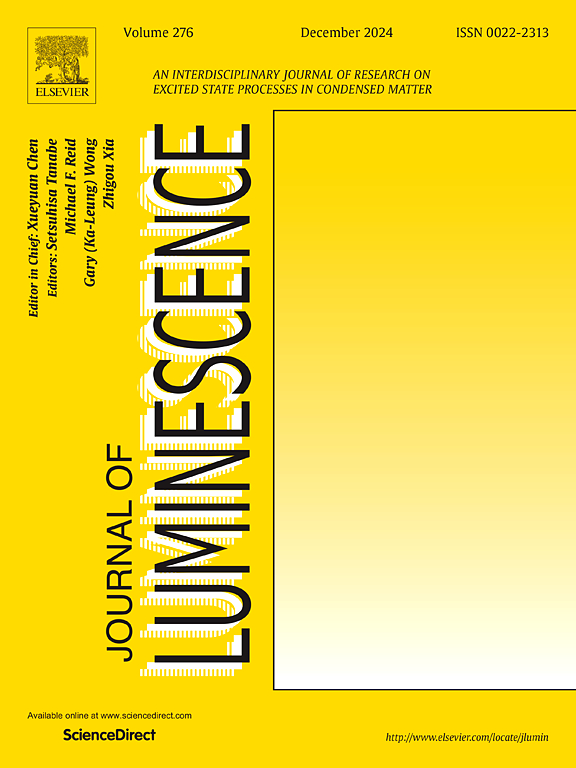Aluminum-gadolinium mixed oxide matrixes doped with optically active lanthanide ions: Potential candidates for biosensing applications
IF 3.3
3区 物理与天体物理
Q2 OPTICS
引用次数: 0
Abstract
The properties of the gadolinium-aluminum-garnet (GAG) crystalline phase allow it to be applied in the medical and technological areas. GAG doping with Eu3+, Yb3+, and Er3+ ions intensifies its spectroscopic properties and paves the way for its use in photovoltaic cells, cancer treatment, and biosensors. In this study, Gd3Al5O12 matrixes doped with lanthanide ions were synthesized by the non-hydrolytic sol–gel route, characterized, and spectroscopically evaluated. For the synthesis, precursor aluminum (AlCl3) and lanthanide (GdCl3, EuCl3, YbCl3, and ErCl3) salts were employed at 5:3:1:1:10 or 10:3:1:1:10 Al3+/Gd3+/Eu3+/Er3+/Yb3+ molar ratio. The resulting lanthanide-doped mixed oxide matrixes consisted of a mixture of GdAlO3 and Gd3Al5O12, and the Al3+/Gd3+ molar ratio influenced phase formation. The effect of the Er3+/Yb3+ molar ratio (1:10, 1:5, or 1:1) on the spectroscopic properties of the matrixes was assessed. The excitation and emission spectra displayed the typical bands of Eu3+ ions. The bands were broadened, which indicated that Eu3+ occupied more than one crystallographic site. The emission spectra presented bands due to Gd3+ ions in the ultraviolet region. When energy up-conversion was investigated under 980-nm laser, the bands typical of Er3+ ions emerged between 550 and 650 nm. Because the lanthanide-doped mixed oxide matrixes synthesized herein have potential application as biosensors, their cytotoxic effects on mammalian cells were tested.
掺杂光学活性镧系离子的铝-钆混合氧化物基质:生物传感应用的潜在候选者
钆铝石榴石(GAG)晶相的特性使其能够应用于医疗和技术领域。掺杂 Eu3+、Yb3+ 和 Er3+ 离子的 GAG 可增强其光谱特性,并为其在光伏电池、癌症治疗和生物传感器中的应用铺平道路。本研究采用非水解溶胶-凝胶路线合成了掺杂镧系离子的 Gd3Al5O12 基体,并对其进行了表征和光谱评估。在合成过程中,前驱体铝盐(AlCl3)和镧盐(GdCl3、EuCl3、YbCl3 和 ErCl3)的摩尔比分别为 5:3:1:1:10 或 10:3:1:1:10 Al3+/Gd3+/Eu3+/Er3+/Yb3+。所得到的掺杂镧系元素的混合氧化物基体由 GdAlO3 和 Gd3Al5O12 混合组成,Al3+/Gd3+ 摩尔比影响相的形成。评估了 Er3+/Yb3+摩尔比(1:10、1:5 或 1:1)对基质光谱特性的影响。激发光谱和发射光谱显示了 Eu3+ 离子的典型谱带。激发光谱和发射光谱显示了 Eu3+ 离子的典型谱带,这些谱带变宽,表明 Eu3+ 离子占据了一个以上的晶体学位点。发射光谱显示了紫外区 Gd3+ 离子产生的条带。在 980 纳米激光下研究能量上转换时,在 550 和 650 纳米之间出现了典型的 Er3+ 离子带。由于本文合成的掺杂镧系元素的混合氧化物基质具有作为生物传感器的潜在应用价值,因此测试了它们对哺乳动物细胞的细胞毒性作用。
本文章由计算机程序翻译,如有差异,请以英文原文为准。
求助全文
约1分钟内获得全文
求助全文
来源期刊

Journal of Luminescence
物理-光学
CiteScore
6.70
自引率
13.90%
发文量
850
审稿时长
3.8 months
期刊介绍:
The purpose of the Journal of Luminescence is to provide a means of communication between scientists in different disciplines who share a common interest in the electronic excited states of molecular, ionic and covalent systems, whether crystalline, amorphous, or liquid.
We invite original papers and reviews on such subjects as: exciton and polariton dynamics, dynamics of localized excited states, energy and charge transport in ordered and disordered systems, radiative and non-radiative recombination, relaxation processes, vibronic interactions in electronic excited states, photochemistry in condensed systems, excited state resonance, double resonance, spin dynamics, selective excitation spectroscopy, hole burning, coherent processes in excited states, (e.g. coherent optical transients, photon echoes, transient gratings), multiphoton processes, optical bistability, photochromism, and new techniques for the study of excited states. This list is not intended to be exhaustive. Papers in the traditional areas of optical spectroscopy (absorption, MCD, luminescence, Raman scattering) are welcome. Papers on applications (phosphors, scintillators, electro- and cathodo-luminescence, radiography, bioimaging, solar energy, energy conversion, etc.) are also welcome if they present results of scientific, rather than only technological interest. However, papers containing purely theoretical results, not related to phenomena in the excited states, as well as papers using luminescence spectroscopy to perform routine analytical chemistry or biochemistry procedures, are outside the scope of the journal. Some exceptions will be possible at the discretion of the editors.
 求助内容:
求助内容: 应助结果提醒方式:
应助结果提醒方式:


